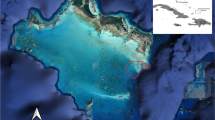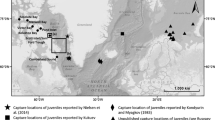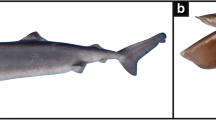Synopsis
Catch records from the Hawai'i Cooperative Shark Research and Control Program, which operated in Hawai'i from 1967–1969, were examined and data on the Galapagos shark,Carcharhinus galapagensis were analyzed. A total of 304 Galapagos sharks was caught, predominantly with longlines. More female sharks were caught than males, and the catch was skewed geographically. On the island of O'ahu the highest catch rates occurred along the north and south coasts. High catch rates also occurred near points of land, where longshore currents converge. Average depth of capture was greater for juveniles (45.1 m) and mature males (60.2 m), than for subadults (38.8 m) and mature female sharks (34.2 m). Males appear to reach maturity between 205 and 239 cm total length, and females between 215 and 245 cm. Litter size ranged from 4 to 16 pups, with an average of 8.7. In Hawaiian waters Galapagos sharks are born at just over 80 cm total length. Mating and parturition apparently occur early in the year, and gestation is estimated to be about 12 months. Stomach contents consisted mainly of teleosts and benthic prey, and ontogenetic changes in diet occurred as sharks increased in size. Sharks consumed a smaller proportion of teleosts and more elasmobranchs with increasing size. Dietary diversity also increased with increasing size of shark.
Similar content being viewed by others

References cited
Bass, A.J. 1977. Long term recoveries of tagged sharks. Copeia 1977: 574–575.
Bass, A.J., J.D. D'Aubrey & M. Kistnasamy.1973. Sharks of the east coast of southern Africa. 1. The genusCarcharhinus (Carcharhinidae). Invest. Rep. Oceanogr. Res. Inst., Durban 33. 168 pp.
Beebe, W. & J. Tee-Van. 1941. Eastern Pacific expeditions of the New York Zoological Society. 25. Fishes from the tropical eastern Pacific. Part 2. Sharks. Zoologica 26: 93–122.
Castro, J.I. 1983. The sharks of North American waters. Texas A & M University Press, College Station. 180 pp.
Compagno, L.J.V. 1984. Sharks of the World. An annotated and illustrated catalogue of shark species known to date. Part 2, Carcharhiniformes. FAO Fish Synop. (125) 4: 251–655.
Cortes, E. & S.H. Gruber. 1990. Diet, feeding habits, and estimates of daily ration of young lemon sharks,Negaprion brevirostris. Copeia 1990: 204–218.
Davies, D.H. & L.S. Joubert. 1967. Tag evaluation and shark tagging in south African waters, 1964–1965. pp. 111–140.In: P.W. Gilbert, R.F. Mathewson & J.P. Rapp (ed.) Sharks, Skates and Rays, Johns Hopkins Press, Baltimore.
De Crosta, M.A., L.R. Taylor Jr. & J.D. Parrish. 1984. Age determination, growth, and energetics of three species of carcharhinid sharks in Hawai'i. pp. 75–95.In: Proceedings of the Second Symposium on Resource Investigations of the Northwestern Hawaiian Islands, Vol. 2, University of Hawai'i Sea Grant, UNIHI-SEAGRANT MR-84-01.
Edwards, A.J. & H.R. Lubbock. 1982. The shark population of Saint Paul's Rocks. Copeia 1982; 223–225.
Garrick, J.A.F. 1967. A broad view ofCarcharhinus species, their systematics and distribution. pp. 85–91.In: P.W. Gilbert, R.W. Mathewson & J.P. Rall (ed.) Sharks, Skates and Rays, Johns Hopkins Press, Baltimore.
Garrick, J.A.F. & L.P. Schultz. 1963. A guide to potentially dangerous sharks. pp. 3–60.In: P.W. Gilbert, J.A.F. Garrick & L.P. Schultz (ed.) Sharks and Survival, D.C. Health & Co., Boston.
Johnson R.H. 1978 Sharks of tropical and temperate seas. Les Editions Du Pacifique. Singapore. 170 pp.
Kato, S. & A.H. Carvallo. 1967. Shark tagging in the eastern tropical Pacific Ocean, 1962–1965. pp. 93–109.In: P.W. Gilbert, R.F. Mathewson & J.P. Rall (ed.) Sharks, Skates and Rays, Johns Hopkins Press, Baltimore.
Krebs, C.J. 1989. Ecological methods. Harper Collins Publishers, New York. 654 pp.
Langton, R.S. 1982. Diet overlap between the Atlantic cod,Gadus morhua, silver hake,Merluccius bilinearis and fifteen other northwest Atlantic finfish. U.S. Fish. Bull. 80: 745–759.
Last, P.R. & J.D. Stevens. 1994. Sharks and rays of Australia. CSIRO, Canberra. 513 pp.
Limbaugh, C. 1963. Field notes on sharks. pp. 53–94.In: P.W. Gilbert, J.A.F. Garrick & L.P. Schultz (ed.) Sharks and Survival, D.C. Heath Co., Boston.
Lowe, C.G., B.M. Wetherbee, G.L. Crow & A.L. Tester. 1996. Ontogenetic dietary shifts and feeding behavior of the tiger shark,Galeocerdo cuvier, in Hawaiian waters. Env. Biol. Fish. (in press).
Pinchuk, V.I. 1981. Mistaken identification of the so-called ‘dogfish’, a member of the gray shark genus,Carcharhinus, from open waters of world oceans. J. Ichthyol. 21: 115–117.
Randall, J.E. 1963. A fatal shark attack by the sharkCarcharhinus galapagensis at St. Thomas, Virgin Islands. Caribb. J. Sci. 3: 201–205.
Reid, D.D. & M. Krogh. 1992. Assessment of catches from protective shark meshing off New South Wales beaches between 1950 and 1990. pp. 283–296.In: J.G. Pepperell (ed.) Sharks: Biology and Fisheries, Aust. J. Mar. Freshwater Res. 43.
Rosenblatt, R.H. & W.J. Baldwin. 1958. A review of the eastern Pacific sharks of the genusCarcharhinus, with a redescription ofC. malpeloensis (Fowler) and California records ofC. remotus (Dumeril). Calif. Fish Game 44: 137–159.
Simpfendorfer, C. 1992. Biology of tiger sharks (Galeocerdo cuvier) caught by the Queensland shark meshing program off Townsville, Australia. pp. 33–43.In: J.G. Pepperell (ed.) Sharks: Biology and Fisheries, Aust. J. Mar. Freshwater Res. 43.
Taniuchi, T., H. Tachikawa, Y. Kurata & Y. Nose. 1985. Galapagos shark,Carcharhinus galapagensis, from the Ogasawara Islands, Japan. Japan. J. Ichthyol. 31: 449–452.
Taylor, L.R. Jr. 1994. Sharks of Hawai'i. University of Hawai'i Press, Honolulu. 126 pp.
Wass, R.C. 1971. A comparative study of the life history, distribution, and ecology of the sandbar shark and gray reef shark in Hawai'i. Ph. D. Dissertation, University of Hawai'i, Honolulu. 219 pp.
Wetherbee, B.M., C.G. Lowe & G.L. Crow. 1994. A review of shark control in Hawaii with recommendations for future research. Pac. Sci. 48: 95–115.
Wetherbee, B.M., S.H. Gruber & E. Cortes. 1990. Diet, feeding habits, digestion, and consumption in sharks with special reference to the lemon shark,Negaprion brevirostris. pp. 29–47.In: H.L. Pratt, Jr., S.H. Gruber & T. Taniuchi (ed.) Elasmobranchs as Living Resources: Advances in the Biology, Ecology, Systematics, and the Status of the Fisheries, NOAA Tech. Rep. NMFS 90.
Yano, K. & S. Tanaka. 1984. Some biological aspects of the deepsea squaloid sharkCentroscymnus from Suruga Bay, Japan. Nippon Suisan Gakkaishi 50: 249–256.
Author information
Authors and Affiliations
Rights and permissions
About this article
Cite this article
Wetherbee, B.M., Crow, G.L. & Lowe, C.G. Biology of the Galapagos shark,Carcharhinus galapagensis, in Hawai'i. Environ Biol Fish 45, 299–310 (1996). https://doi.org/10.1007/BF00003099
Received:
Accepted:
Issue Date:
DOI: https://doi.org/10.1007/BF00003099



